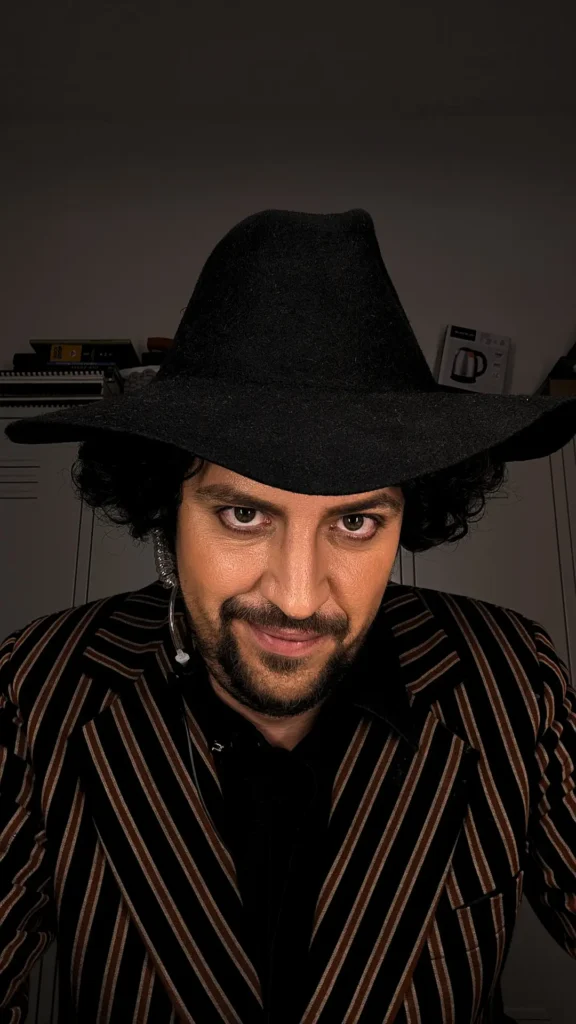DANCAIRO
The rol of Dancairo from «Carmen», composed by George Bizet, will be performed at Stadttheater Pforzheim during the whole 2025-26 season

ROLE INFORMATION
NAME: Dancaïro
AGE: Somewhere over his 30s
PROFESSION/STUDIES: Thief/Smuggler
FAMILY: The Gypsies Band is his family
FRIENDS: Remendado, Frasquita, Mercedes & Carmen
LOVE: Money
PHYSICAL DESCRIPTION: height undetermined, size undetermined. He likes to dress elegant, resembling an Italian mafia boss. Short beard or goatee
PSYCHOLOGICAL DESCRIPTION: defiant gaze and a sly smile. He is a true gypsy organized crime boss. He has all the plans in his head and rules the entire gang with an iron fist. He has a paternal weakness for Carmen
HOBBIES: exploiting children to steal, doing dirty business with the Spanish security forces, drinking “Mum’s Liquor”, robbing his clients, and organizing riots
FAVORS: he has a very strong personality and is very smooth-talking
DEFECTS: He indulges Carmen as if she were his daughter. He is very greedy
PERSONAL ITEMS: Gypsy hat, a Spanish knife, and a fake silk scarf
WHAT IF
What would happen if the character of Lillas Pastia didn’t exist in the opera Carmen?
I would be the owner of the bar and use it as a cover for smuggling! Ha, ha. That’s me, Dancaïro.
The boss of all the smugglers and the owner of the bar where every night we make a fortune from involuntary “tips” … Oops!
What would happen if Zuñiga were a Spanish general during the Dictatorship?
Well, I would “hire” his services so I could steal whatever I wanted, however I wanted, and at the same time I would devise a plan to kill him… Oops!
But one thing I must be clear, I don’t care if your name is Zuñiga, Don Jose, or Escamillo… Carmen is the pearl of my gang, and she belongs to our family… Try to lay a finger on her and you’ll lose it before you know it.
Daggers and pistols,
Your trusted Dancaïro
SYNOPSIS
«Carmen»
Le Dancaire is a minor but recognizable character in Georges Bizet’s opera Carmen (premiered in 1875 at the Opéra-Comique in Paris).
Dancaïro is one of the smugglers who appear in the opera, alongside his companion, Remendado. His role is that of an accomplice and comic secondary figure within the group of gypsies and smugglers with whom Carmen associates. He represents the marginal and free world of smuggling, in contrast to the social order represented by Don José.
He appears in Act II and Act III. He enters Lillas Pastia’s tavern with Remendado to convince Carmen and her friends (Frasquita and Mercédès) to accompany them on a smuggling expedition. This is where the famous “Smugglers’ Quintet” (“Nous avons en tête une affaire”) begins, a light and lively piece that shows the complicity of the group. Later, he helps Carmen at the end of the second act when Zuniga appears in the tavern and incites Don José to kill him and join his band of smugglers.
In Act III, we find him in the mountains, in the smugglers’ hideout. He reappears in the choruses and scenes describing the life of smuggling. He talks with Carmen and the others about the enterprise and prepares for action. At the end of Act III, he is the character who ends up separating Escamillo and Don José when they become embroiled in their dispute over Carmen.
It is a vocally ambiguous role performed mainly by baritones (although it can sometimes be sung by a bass-baritone with good high notes or a spinto tenor with good low notes). His parts are relatively short, but his participation in the quintet is essential: he contributes to the liveliness of one of the most famous scenes in the opera. His music is not as lyrical or developed as that of Carmen, Don José, or Escamillo, but it does show the lighthearted, mischievous, and conspiratorial character of the world of smugglers.
Curiosity
The name “Dancaïro” is not a real surname, but a nickname, taken from the short novel Carmen by Prosper Mérimée (1845), in which smugglers with colorful nicknames appear.